Abstract
Background
Rathke’s cleft cyst is known as an indolent disease, but has become intractable in a few cases. In this clinical investigation, the initial operative outcomes of Rathke’s cleft cyst and the mechanism of re-accumulation were investigated to identify the optimum surgical strategy for the second operation.
Methods
We conducted a retrospective review of 155 patients with Rathke’s cleft cyst (58 males and 97 females, aged from 13 to 84 years) surgically treated between April 1996 and March 2010. The same initial operative strategy was adopted in all patients. Operative outcomes and prognostic factors were investigated.
Findings
Re-accumulation occurred in 27 patients (17.4%), and re-operation was required in eight patients because of neurological deficits (5.2%). Three types of re-accumulating mechanism were identified. First, cysts with cerebrospinal fluid (CSF)-like intensity on magnetic resonance imaging had a higher risk of re-accumulation (logrank test, p < 0.001). The cyst wall should be extensively removed in the suprasellar cistern to allow communication between the cyst and CSF spaces at the second operation. Second, cysts with epithelial transition had a significant higher risk of re-accumulation compared to other types of epithelium (logrank test, p < 0.001). Aggressive removal and irradiation should be performed at the second treatment. Third, classic Rathke’s cleft cyst was found in the majority of cases. No change in operative strategy is required at the second treatment with lower risk of intractability.
Conclusions
Enlargement of Rathke’s cleft cyst requiring re-treatment needs selection of surgical strategy according to the individual re-accumulation mechanism.







Similar content being viewed by others
References
Aho CJ, Liu C, Zelman V, Couldwell WT, Weiss MG (2005) Surgical outcomes in 118 patients with Rathke cleft cysts. J Neurosurg 102:189–193
Benveniste RJ, King WA, Walsh J, Lee JS, Naidich TP, Post KD (2004) Surgery for Rathke cleft cysts: technical considerations and outcomes. J Neurosurg 101:577–584
Burger PC, Scheithauer BW (1994) Tumors of the central nervous system. Armed Forces Institute of Pathology, Washington, DC, pp 357–359
Cotran SR, Kumar V, Robbins SL (1989) Robbins pathologic basis of disease, 4th edn. Saunders, Philadelphia, p 34
Hofmann BM, Kreutzer J, Saeger W, Buchfelder M, Blumcke I, Fahlbusch R, Buslei R (2006) Nuclear beta-catenin accumulation as reliable marker for the differentiation between cystic craniopharyngiomas and Rathke cleft cysts: a clinico-pathologic approach. Am J Surg Pathol 30:1595–1603
Ikeda H, Yoshimoto T (2002) Clinicopathological study of Rathke’s cleft cysts. Clin Neuropathol 21:82–91
Kim JE, Kim JH, Kim OL, Paek SH, Kim DG, Chi JG, Jung HW (2004) Surgical treatment of symptomatic Rathke cleft cysts: clinical features and results with special attention to recurrence. J Neurosurg 100:33–40
Koutourousiou M, Grotenhuis A, Kontogeorgos G, Seretis A (2009) Treatment of Rathke’s cleft cysts: experience at a single centre. J Clin Neurosci 16:900–903
Laws ER, Kanter AS (2004) Editorial. Rathke cleft cysts. J Neurosurg 101:571–572
Le BH, Towfighi J, Kapadia SB, Lopes MB (2007) Comparative immunohistochemical assessment of craniopharyngioma and related lesions. Endocr Pathol 18:23–30
Matsushima T, Fukui M, Fujii K, Kinoshita K, Yamakawa Y (1988) Epithelial cells in symptomatic Rathke’s cleft cysts. A light- and electron-microscopic study. Surg Neurol 30:197–203
Mukherjee JJ, Islam N, Kaltsas G, Lowe DG, Charlesworth M, Afshar F, Trainer PJ, Monson JP, Besser GM, Grossman AB (1997) Clinical, radiological and pathological features of patients with Rathke’s cleft cysts: tumors that may recur. J Clin Endocrinol Metab 82:2357–2362
Ogawa Y, Tominaga T, Ikeda H (2007) Clinicopathological and endocrinological study of Rathke’s cleft cyst manifesting as hyponatremia. Neurol Med Chir (Tokyo) 47:58–64
Ogawa Y, Tominaga T (2010) A partially ossified solid and cystic Rathke cleft cyst. Case report. J Neurosurg 112:1324–1326
Oka H, Kawano N, Yagishita S, Suwa T, Yoshida T, Maezawa H, Utsuki S, Kameya T, Fujii K (1995) Origin of ciliated craniopharyngioma: pathological relationship between Rathke cleft cyst and ciliated craniopharyngioma. Noshuyo Byori 12:97–103
Palaoglu S, Akbay A, Mocan G, Onol B, Ozcan OE, Bertan V (1994) Ossified adamantinomatous type craniopharyngiomas. A series of 13 patients. Acta Neurochir (Wien) 127:166–169
Tate MC, Jahangiri A, Blevins L, Kunwar S, Aghi MK (2010) Infected Rathke cleft cysts: distinguishing factors and factors predicting recurrence. Neurosurgery 67:762–769
Thaper K, Kovacs K (1998) Neoplasms of the sellar region. In: Binger DD, McLendon RE, Bruner JM (eds) Russell and Rubinstein’s pathology of tumors of the nervous system, 2nd edn. Arnold, London, pp 648–652
Voelker JL, Campbell RL, Muller J (1991) Clinical, radiographic, and pathological features of symptomatic Rathke’s cleft cysts. J Neurosurg 74:535–544
Wolfe SQ, Heros RC (2010) Editorial. A Rathke cleft cyst to craniopharyngioma: is there a spectrum? J Neurosurg 112:1322–1333
Acknowledgements
We thank and appreciate Dr. Hidetoshi Ikeda (South Tohoku Hospital, Koriyama, Japan) for helping us with the pathological analysis.
Conflicts of interest
None.
Author information
Authors and Affiliations
Corresponding author
Additional information
Comment
This is a nice study of RCCs and their recurrence potential, which seems to relate to MRI intensities.
The authors are reporting from a unit with a large experience and 10% approximately of their cases are RCCs.
The discussion regarding histology has been grumbling on for years—the comments by Wolfe and Heros are very typical of what are discussed, but see comments on El Mahady and Powell in Neurosurgery 42(1998), pp 16/17. Clearly, even 13 years ago these matters had been considered. However, there are distinct monoclonal staining properties that absolutely differentiate between the two. It is interesting that if there really is a transition from RCC to craniopharyngioma, that the monoclonal staining, which is distinctively different between the two can change.
Michael Powell
London, UK
Rights and permissions
About this article
Cite this article
Ogawa, Y., Watanabe, M. & Tominaga, T. Prognostic factors of operated Rathke’s cleft cysts with special reference to re-accumulation and recommended surgical strategy. Acta Neurochir 153, 2427–2433 (2011). https://doi.org/10.1007/s00701-011-1072-8
Received:
Accepted:
Published:
Issue Date:
DOI: https://doi.org/10.1007/s00701-011-1072-8




